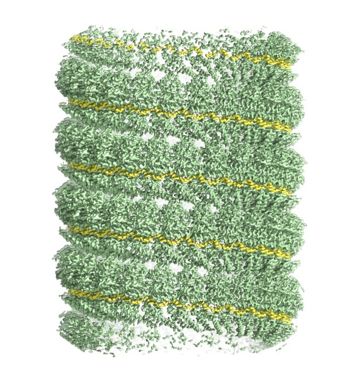Structure of the Ebola virus nucleoprotein - RNA complex
Robert N. Kirchdoerfer, Erica Ollmann Saphire, Andrew B. Ward [1]
Molecular Tour
Ebola virus is capable of causing a deadly hemorrhagic fever. After entering host cells, the virus must replicate and transcribe its RNA genome to replicate and produce viral proteins to form new viruses. Ebola virus uses a large protein-RNA complex called the nucleocapsid to carry out these replication and transcription functions. The nucleocapsid contains the viral RNA genome which is completely covered in viral proteins forming large helical filaments. The Ebola virus nucleoprotein is responsible for binding to the RNA, forming these large filamentous structures and presenting binding sites for additional viral proteins. Here we used cryo-electron microscopy to determine a high-resolution structure of the Ebola virus nucleoprotein bound to RNA (6nut). In addition to showing detailed contacts between nucleoprotein and RNA, this structure also shows how contacts between individual nucleoproteins create the large helical structure of the nucleocapsid (see static image below).

EM reconstruction of the helical NP filament, RNA is shown in yellow
- , the central monomer is in dark green, RNA is shown in yellow.
- .
- . Note how the N terminus of NP reaches over to contact the adjacent NP.
- including several basic residues contacting the acidic RNA as well as hydrophobic surfaces stacking on nucleotide bases.
PDB reference: Ebola virus nucleoprotein - RNA complex, 6nut.
References
- ↑ Kirchdoerfer RN, Saphire EO, Ward AB. Cryo-EM structure of the Ebola virus nucleoprotein-RNA complex. Acta Crystallogr F Struct Biol Commun. 2019 May 1;75(Pt 5):340-347. doi:, 10.1107/S2053230X19004424. Epub 2019 Apr 24. PMID:31045563 doi:http://dx.doi.org/10.1107/S2053230X19004424


